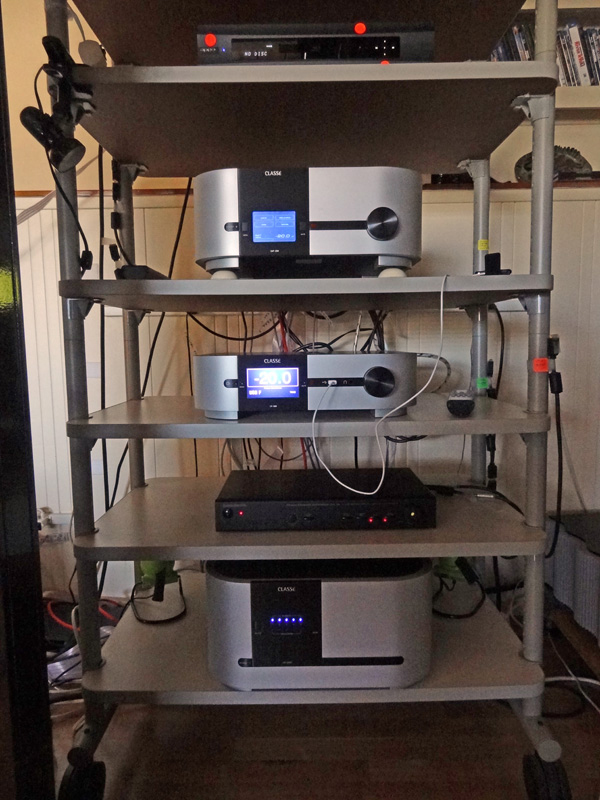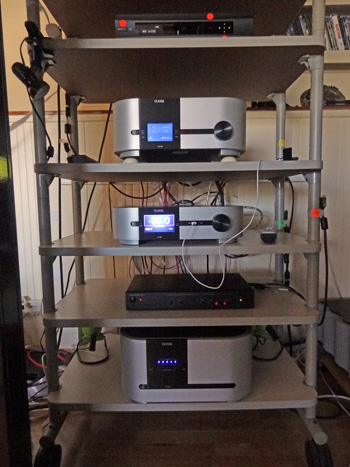Introduction
For those of us who enjoy two-channel (stereo) audio using a high-end system, but also like our home theater with surround sound, how to integrate the two setups without compromising the stereo high-end system has been a conundrum. In this article, I will show you how to have both systems interconnected, but not compromise the sound when you want to listen to your stereo CDs, or SACD in stereo.
Setup
For the setup, I used an OPPO BDP-95 universal player, Classé CP-800 stereo preamplifier, Classé CA-5200 five-channel (5 x 200 watts) power amplifier, Classé SSP-800 surround sound processor, Threshold ES-500 electrostatic speakers (front main left/right), Paradigm Signature C5 center channel speaker, and Final Sound electrostatic speakers (surrounds).
I worked on this for several weeks, using various connections, and below is shown a schematic of the setup that gave me the most flexibility, allowing me to use the system to play two-channel discs, including CDs and stereo SACDs, as well as music stored on my iPod (*.wav files, not compressed), with only the player, the Classé CP-800 and Classé CA-5200 in the signal path, or as an alternative, playing surround sound SACDs, DVD-A multi-channel discs, and of course, watch movies, with the Classé SSP-800 surround sound processor in the loop along with the other power amplifier channels in the CA-5200.
Click on the schematic to see the full-sized version, then put the mouse cursor on the schematic, hold down the left mouse key and move the schematic to the side, so you can read the description here while you look at the diagram.
The OPPO BDP-95 is connected to the Classé CP-800 preamplifier, using a pair of XLR cables. I utilized the OPPO’s XLR analog outputs because of the Sabre 32 bit DACs that it has, in differential configuration, but you could also use the coax digital output from the OPPO to the CP-800. Just try them both out and see which sounds best to you.
The OPPO also has an HDMI cable that is connected to the Classé SSP-800. From the CP-800, there is a pair of XLR cables that go to two of the five channels in the CA-5200. The center channel and rear surround XLR outputs on the SSP-800 are connected, via XLR cables, to the other three channels of the CA-5200. The front left and right pre-outs of the SSP-800 (RCA jacks) are connected to the line-in RCA jacks on the CP-800.
I have the CP-800 configured for using stereo subwoofers, with a crossover frequency of 60 Hz. This eliminates the membrane in the ES-500 electrostatic speakers from touching the stators, which they tend to do when playing low frequencies at high volume level. The respective two subwoofers are situated next to the ES-500s, so the directionality (being able to detect where the sound is coming from) that occurs above about 50 Hz is not noticeable.
In Use
Being able to bypass the processor (processors and some preamplifiers have “pass-through” connections for using them in one system) made a big difference in the sound. I simply selected Balanced 1 as the input to the CP-800, and this produced the circuit consisting of the universal player, the CP-800 preamplifier, and two channels of the CA-5200 power amplifier, driving the front two electrostatic speakers, for stereo listening. All of the fine detail, rich, low-distortion music came through clearly.
Note that you don’t have to use subwoofers connected to the CP-800 if you don’t want to. In this case, you would disable the bass management menu, and you would get the entire signal going to the output jacks, with no DSP involved. This would be the two-channel audio “purist” setup, but your speakers should be full range if you want to set the system up this way.
If one uses a pass-through connection, an extra set of input and output jacks, as well as the interconnects required to connect them, are added to the circuit, and this definitely causes some signal degradation. It may not be much, but it does degrade, and it’s unavoidable. If you don’t want to deal with having two volume controls for surround sound (the SSP-800 and CP-800), you can engage the CP-800’s pass-through in the menu. Also, the CP-800 offers an unusual bass management feature, which lets you run an analog signal through the CP-800 to the main left and right outputs while also having one or two subwoofer outputs. In this case, there is no high-pass filter, so the natural roll-off of the mains would occur, but the benefit is that there is no DSP involved in the CP-800 if you set it up this way.
I also used this setup with my iPod by selecting USB F as the input. I have hours of Baroque chamber music stored there, which I play on the system all day long while I work.
For surround sound, I put an SACD or DVD-A in the player, select Line 1 on the CP-800, turn on the SSP-800 and select the DVD player input, and I have 5.1 music. The signal path is via HDMI to the SSP, and the front left/right pre-outs from the SSP-800 to the Line 1 input on the CP-800. So, I have to adjust the volume control on both the SSP-800 and the CP-800 to get the proper volume in the front left/right channels. Actually, this turned out to be serendipity, because surround sound music, as well as movies, tend to have varied balance between the center channel and the front left and right channels, and in order to adjust the volume of any channel, you have to scroll through a menu and adjust each channel one at a time. With the combination of the SSP-800 and CP-800, balancing the front left and right channel volume to match the center is a simple press of the volume control button on the CP-800 remote control.
Of course, surround sound and movies go through the SSP-800, and although it is a very good one, the front left and right channels have a bit more distortion than when just using the CP-800. However, being enveloped in discrete multi-channel sound makes up for any – possibly inaudible – increase in distortion in two of the channels.
Conclusions
When I first tested the Classé CP-800, I knew it would be ideal for integrating with a surround sound system, but in a way that would let me bypass the Classé SSP-800 without having to use a pass-through connection. The system sounds terrific, and I have my choice of stereo listening as if there were no other components in the system at all, or surround sound music, and of course, movies. If you have a home theater system that you also use for stereo music listening, and you used to have a dedicated high-end stereo audio system, now you can have both, with just the addition of a component like the Classé CP-800 that seems to have been designed with such use in mind.
A photo of the current rack setup is shown below.





